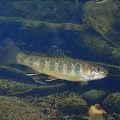“Dotty” Ballantyne: The Triumph of Wit and Will

Dotty and her guide—here, she’s in the Bahamas—back away from a just-released lemon shark. Lemons, especially when confronted, can become aggressive. Fitz Coker photo
TWO DECADES AGO, Dotty Ballantyne was vacationing with her teenaged sons in Jackson, Wyoming. She and her sister owned a mountain home there. That’s when she decided that her family should all learn to fly fish. What followed now carries Dotty on a whirlwind romp through the rarified heights of competitive angling.
A Baltimore native and a graduate of Sarah Lawrence College, she received her M.B.A. from the University of Wisconsin and began a career in financial services.
The trail led her to Jackson.
Dotty’s husband Fitz Coker—friends introduced them in Montana—seasoned their marriage with salt. He owned a home in Key West, Florida. Her introduction to the flats was no easy matter. “I had to stand on the bow with a big rod in my hand and tons of fly line piled on my feet,” she told me.
“And I was expected to see fish.” No small order.
“Oh my God,” she says “I didn’t see fish.” She didn’t know whether to fake it or confess. She prayed that no fish would appear. Get her off the bow. Please.
As she fished more with Fitz, she began to “loosen up.” She started loving those early mornings—especially the rolling tarpon. “You’d see them swimming down Sugarloaf Beach against that gorgeous white sand bottom from half a mile away,” says Dotty. “Sensational!”
She recalls one huge tarpon that she hooked on six-pound test. Six hours later it wasn’t beaten. Dotty got it to the boat—two, three, four times. But her helpers just couldn’t get it in. Guide Doug Kilpatrick and Fitz estimated the fish at 120 pounds. The boat’s transmission failed. They could go only backward. They had to follow the fish in reverse for an hour.
“Ah,” says Ballantyne, reflecting years later, “The ones that get away.”
For Dotty, big fish are part of the equation. Glance at her list of I.G.F.A. records and you’ll discern a pattern of super-fine leaders. “I do love fishing light tippets,” she tells me. “It’s challenging, and that’s where I think my small amount of talent lies: light hands and patience.” She calls it becoming one with the fish.
One hundred forty-nine fly-rod world records to date—hardly “small talent.” In fact, fishing at this level several years ago won Dotty an I.G.F.A. Lifetime Achievement Award. Still, was she always that competitive?
“Yes!” Dotty answers emphatically. “I am drawn to any challenge. I do love my tennis and am so happy to still be able to play. We were a family of five girls and we all played it competitively. It’s very important to me.”
Dotty also cross-country skis, and goes to the gym whenever possible. After reading the following, you’ll understand why. Could Dotty recall an especially memorable catch?
“Special catch?” she says. “Hmm—I remember plenty of fish that I didn’t land, but I think the most memorable that didn’t get away was the 75-pound lemon shark on four-pound test.”
The fish ran under the boat several times after a long fight. She never dreamed she would be able to land it. They had a net. They had a tailer—a spring-loaded device with a collapsible cable loop designed to hold fish by the base of their tails. But when Fitz tried to net it for the hundredth time, it bit and held onto the net. The guide could finally slip the tailer over its tail. Wow, thought Dotty, we finally have it!
Then there was the time Fitz dove in after the blacktip shark. They were on Andros Island, in the Bahamas, up a saltwater creek loaded with blacktips. Dotty hooked a nice one on six-pound-test. She fought it for more than an hour.
But she wasn’t making much headway.
“Elevate the fish!” Fitz kept yelling. Her arms ached. The tailer refused to work. The loops wouldn’t close. “Get that damned net!” Dotty said, screaming and spitting.
Fitz poised with the net. The shark had run out of the creek and was swimming along the shoreline in eight feet of choppy water. After several failed attempts, Fitz finally slipped enough mesh over its head to cause it to panic. The handle flew off to the left, while both fish and net headed straight for the bottom. They could see the fish, still on the line, with the net on top. What’s next? Dotty recalls thinking.
That’s when Fitz decided to jump in after it.
“Oh, my lord,” says Dotty. “We’re an hour from the lodge. And the sea plane that could take us to Nassau is back in Fort Lauderdale.”
The tall, strapping guide asked Fitz, weakly, “Do you want me to go?
“No,” said Fitz, flatly, stripping down to his Parisian skivvies, diving in and swimming down to the fish. Fitz touched the net. Dotty saw a huge commotion: a riot of bubbles, sand and swirling water. Then Fitz shot back to the surface and climbed back in the boat. Dotty couldn’t help
thinking: Whew—I’m glad that’s over!
But the net was still on the bottom. The shark was on top, still attached to the line. What now? Fitz spied a huge hook in the boat. He told the guide to move the boat slowly over to where we’d last seen the net. Then he lowered the hook and snagged it. Dotty was back in business. The shark was pooped. A few more “elevations” and some careful netting, and Fitz had it.
“What do we do now?” asked the guide.
“Haul ass to shore to weigh it!” Fitz commanded.
The blacktip weighed 33 pounds. Upon release it swam away unharmed. The photos Dotty sent to the I.G.F.A. showed Fitz in his skivvies, bought years before in Paris.
But that wasn’t Dotty’s most difficult catch. Of all the species she has successfully pursued, she thinks an amberjack is toughest for sheer tenacity. However, some light-tippet fish were the most nerve-wracking. Sometimes, she tried multiple times, even multiple years, in order to catch them.
Ted Lund, a former Key West guide, has a few observations on female fly fishers: “I think the best one out there now is Dotty Ballantyne.” Lund had several chances to fish with her when she and her husband chartered Captain R. T. Trosset. He usually went along as the gaff man or the net thrower. He remembers a day on the water several years back when Ballantyne caught world-record African pompano, king mackerel, a big ’cuda, as well as a cobia on fly—he thinks five records total. On the worst day, Ted says, he straight-gaffed a 114-pound, 12-ounce bull shark for Dotty. It’s still a 16-pound-tippet world record.
“Dotty is extremely patient,” says Lund. “And she realizes that it takes action to bring up more action.” Meaning you don’t just start fly fishing: you have a place staked out. Then you get a commotion going. You see what shows up. That’s quite an endorsement from someone who was an editor for Salt Water Sportsman and Fly Fishing in Salt Waters magazines.
As Dotty Ballantyne sums up a life well-lived, she conveys her commitment to goals, both setting and attaining them, and her zest for living.
“I had a career in the financial services industry,” she says. “I loved my work.” She worked on a variety of projects for a large international company. And she did some consulting in Great Britain, Australia and Lithuania. She enjoyed that most.
Back in her Montana days, Dotty purchased land on the Yellowstone River, and then donated a portion as a conservation easement, thereby preventing any future development. That’s called giving back.
For the record: Dotty does fish for fun—although it’s usually for records.
“The future for women in fly fishing is wide open,” says Dotty. “I know many women who are great anglers.” She suspects there were plenty of others that she doesn’t know, and that many more, both young and old, are currently being introduced to the sport. I agree.
Author’s note: By the last time Dotty and I communicated (early in 2018), she had landed more than 150 fly-rod world records.
Excerpted with permission from Fifty Women Who Fish (Wild River Press, April 2019); all rights reserved.












